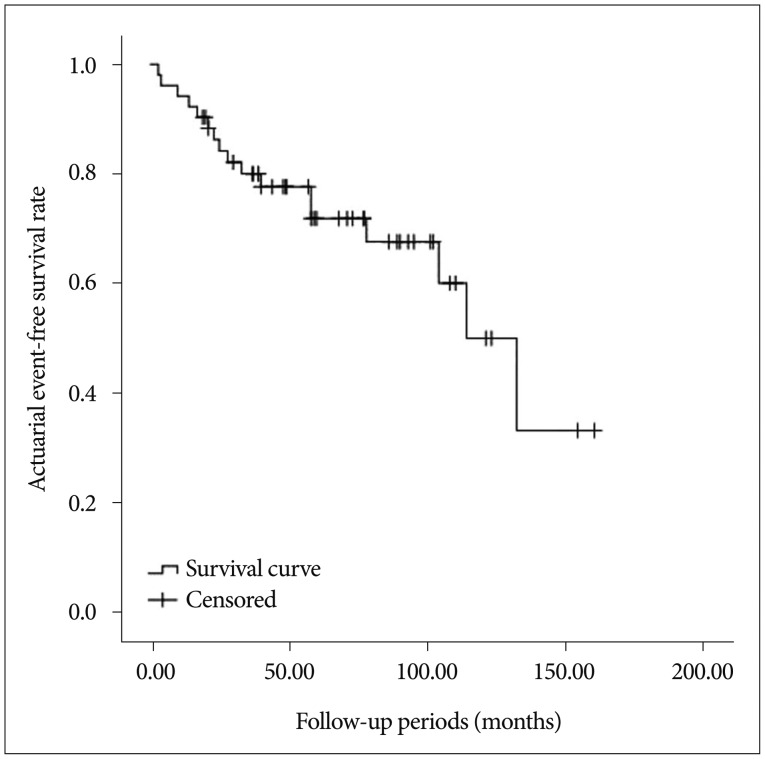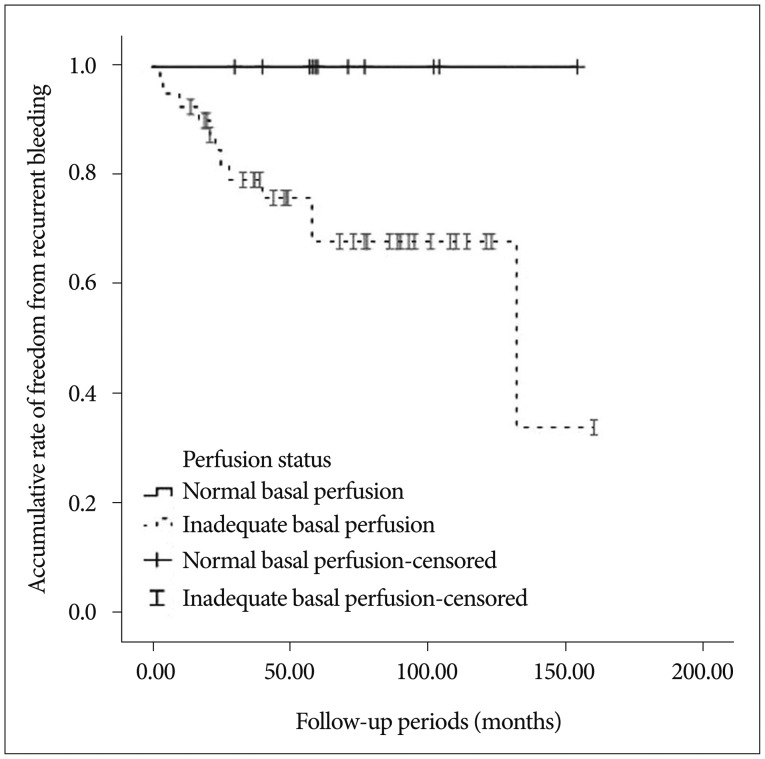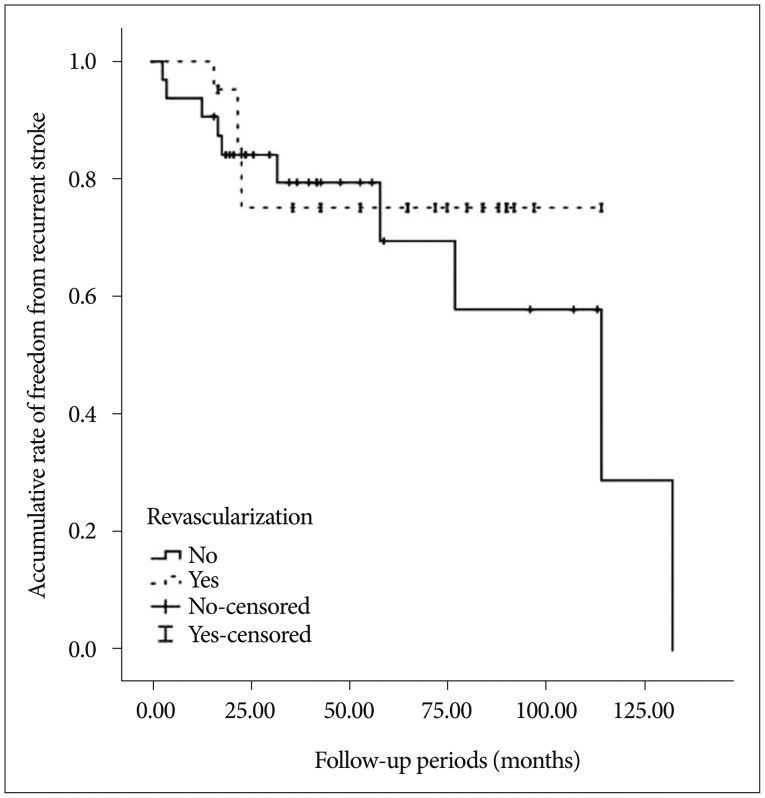J Korean Neurosurg Soc.
2016 Mar;59(2):117-121. 10.3340/jkns.2016.59.2.117.
Recurrent Bleeding in Hemorrhagic Moyamoya Disease : Prognostic Implications of the Perfusion Status
- Affiliations
-
- 1Department of Neurosurgery, Samsung Medical Center, Sungkyunkwan University School of Medicine, Seoul, Korea. nsschong@skku.edu
- KMID: 2192040
- DOI: http://doi.org/10.3340/jkns.2016.59.2.117
Abstract
OBJECTIVE
Hemorrhagic moyamoya disease (hMMD) is associated with a poor clinical course. Furthermore, poorer clinical outcomes occur in cases of recurrent bleeding. However, the effect of hemodynamic insufficiency on rebleeding risk has not been investigated yet. This study evaluated the prognostic implications of the perfusion status during the clinical course of adult hMMD.
METHODS
This retrospective study enrolled 52 adult hMMD patients between April 1995 and October 2010 from a single institute. Demographic data, clinical and radiologic characteristics, including hemodynamic status using single photon emission computed tomography (SPECT), and follow up data were obtained via a retrospective review of medical charts and imaging. Statistical analyses were performed to explore potential prognostic factors.
RESULTS
Hemodynamic abnormality was identified in 44 (84.6%) patients. Subsequent revascularization surgery was performed in 22 (42.3%) patients. During a 58-month (median, range 3-160) follow-up assessment period, 17 showed subsequent stroke (hemorrhagic n=12, ischemic n=5, Actuarial stroke rate 5.8+/-1.4%/year). Recurrent hemorrhage was associated with decreased basal perfusion (HR 19.872; 95% CI=1.196-294.117) and omission of revascularization (10.218; 95%; CI=1.532-68.136).
CONCLUSION
Decreased basal perfusion seems to be associated with recurrent bleeding. Revascularization might prevent recurrent stroke in hMMD by rectifying the perfusion abnormality. A larger-sized, controlled study is required to address this issue.
MeSH Terms
Figure
Reference
-
1. Baba T, Houkin K, Kuroda S. Novel epidemiological features of moyamoya disease. J Neurol Neurosurg Psychiatry. 2008; 79:900–904. PMID: 18077479.
Article2. Gross BA, Du R. Adult moyamoya after revascularization. Acta Neurochir (Wien). 2013; 155:247–254. PMID: 23108563.
Article3. Han JS, Abou-Hamden A, Mandell DM, Poublanc J, Crawley AP, Fisher JA, et al. Impact of extracranial-intracranial bypass on cerebrovascular reactivity and clinical outcome in patients with symptomatic moyamoya vasculopathy. Stroke. 2011; 42:3047–3054. PMID: 21903951.
Article4. Hwang K, Hwang G, Kwon OK. Endovascular embolization of a ruptured distal lenticulostriate artery aneurysm in patients with moyamoya disease. J Korean Neurosurg Soc. 2014; 56:492–495. PMID: 25628809.
Article5. Kawaguchi S, Okuno S, Sakaki T. Effect of direct arterial bypass on the prevention of future stroke in patients with the hemorrhagic variety of moyamoya disease. J Neurosurg. 2000; 93:397–401. PMID: 10969936.
Article6. Kikuta K, Takagi Y, Nozaki K, Sawamoto N, Fukuyama H, Hashimoto N. The presence of multiple microbleeds as a predictor of subsequent cerebral hemorrhage in patients with moyamoya disease. Neurosurgery. 2008; 62:104–111. discussion 111-112PMID: 18300897.
Article7. Kobayashi E, Saeki N, Oishi H, Hirai S, Yamaura A. Long-term natural history of hemorrhagic moyamoya disease in 42 patients. J Neurosurg. 2000; 93:976–980. PMID: 11117870.
Article8. Kuroda S, Hashimoto N, Yoshimoto T, Iwasaki Y. Research Committee on Moyamoya Disease in Japan. Radiological findings, clinical course, and outcome in asymptomatic moyamoya disease : results of multicenter survey in Japan. Stroke. 2007; 38:1430–1435. PMID: 17395863.
Article9. Liu X, Zhang D, Shuo W, Zhao Y, Wang R, Zhao J. Long term outcome after conservative and surgical treatment of haemorrhagic moyamoya disease. J Neurol Neurosurg Psychiatry. 2013; 84:258–265. PMID: 23012444.
Article10. Miyamoto S, Yoshimoto T, Hashimoto N, Okada Y, Tsuji I, Tominaga T, et al. Effects of extracranial-intracranial bypass for patients with hemorrhagic moyamoya disease : results of the Japan Adult Moyamoya Trial. Stroke. 2014; 45:1415–1421. PMID: 24668203.
Article11. Morioka M, Hamada J, Kawano T, Todaka T, Yano S, Kai Y, et al. Angiographic dilatation and branch extension of the anterior choroidal and posterior communicating arteries are predictors of hemorrhage in adult moyamoya patients. Stroke. 2003; 34:90–95. PMID: 12511756.
Article12. Nariai T, Matsushima Y, Imae S, Tanaka Y, Ishii K, Senda M, et al. Severe haemodynamic stress in selected subtypes of patients with moyamoya disease : a positron emission tomography study. J Neurol Neurosurg Psychiatry. 2005; 76:663–669. PMID: 15834024.13. Okada Y, Shima T, Nishida M, Yamane K, Yamada T, Yamanaka C. Effectiveness of superficial temporal artery-middle cerebral artery anastomosis in adult moyamoya disease : cerebral hemodynamics and clinical course in ischemic and hemorrhagic varieties. Stroke. 1998; 29:625–630. PMID: 9506603.
Article14. Ryan RW, Chowdhary A, Britz GW. Hemorrhage and risk of further hemorrhagic strokes following cerebral revascularization in Moyamoya disease : a review of the literature. Surg Neurol Int. 2012; 3:72. PMID: 22937473.
Article15. Saeki N, Nakazaki S, Kubota M, Yamaura A, Hoshi S, Sunada S, et al. Hemorrhagic type moyamoya disease. Clin Neurol Neurosurg. 1997; 99(Suppl 2):S196–S201. PMID: 9409437.
Article16. Starke RM, Komotar RJ, Connolly ES. Optimal surgical treatment for moyamoya disease in adults : direct versus indirect bypass. Neurosurg Focus. 2009; 26:E8. PMID: 19335134.17. Suzuki J, Takaku A. Cerebrovascular "moyamoya" disease. Disease showing abnormal net-like vessels in base of brain. Arch Neurol. 1969; 20:288–299. PMID: 5775283.
- Full Text Links
- Actions
-
Cited
- CITED
-
- Close
- Share
- Similar articles
-
- Evaluation of EDAS in Moyamoya Disease with Brain SPECT: Case Report
- The News on Moyamoya Disease: Review Article
- Cerebral Hemodynamic Analysis in Pediatric Moyamoya Patients using Perfusion Weighted MRI
- Usefulness of CT Perfusion Imaging in Adult Moyamoya Disease
- Hemorrhagic Moyamoya Disease : A Recent Update




